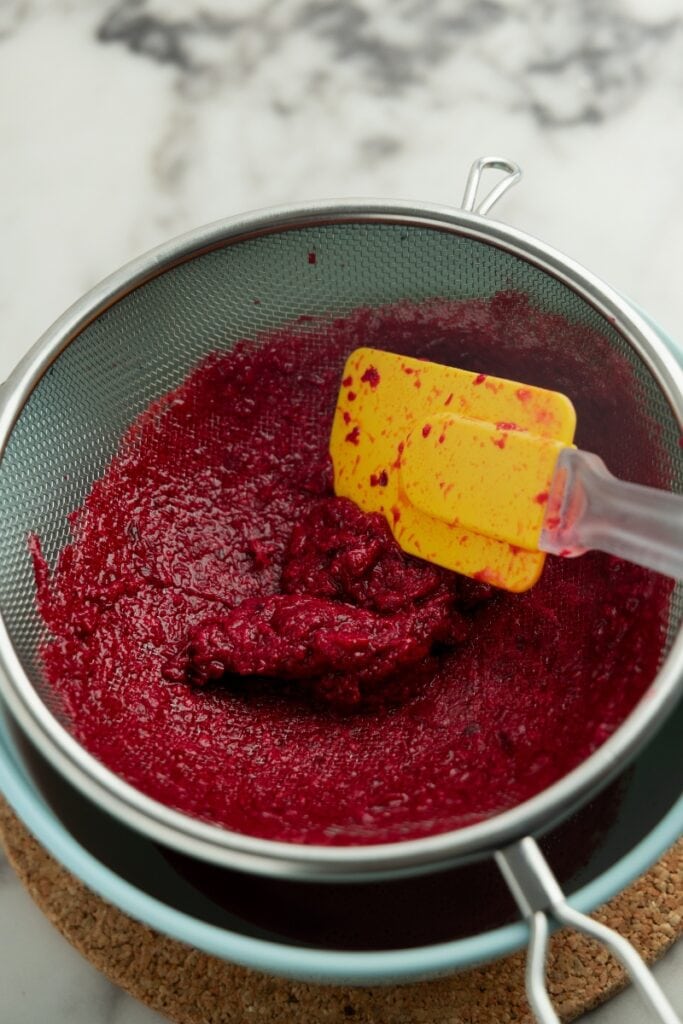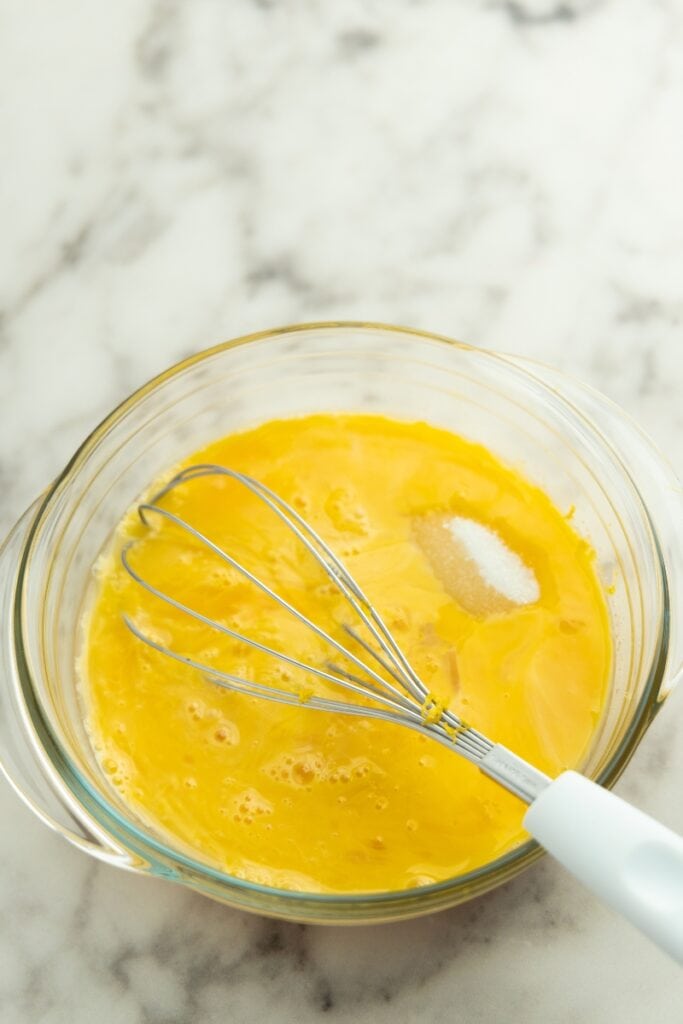Cherry Curd
This post may contain affiliate links. Read our privacy policy.
Cherry curd is a versatile cherry-flavored fruit spread that can fill cakes, tarts, eclairs, or macarons. It can also add a bit of tartness to a parfait or be drizzled over ice cream, waffles, or pancakes.
Recipe At a Glance
Fruit curd recipes are simple, and cherry curd is no different.
You start by making cherry puree, which you then cook together with lemon juice and use to temper eggs and yolks. Once done, all that’s left is to add butter and wait until the curd cools down.
The process is simple, and if you’ve ever made another curd in your life, you’ll feel at home with this one.
Making cherry curd for the first time? Read the ingredients notes, step-by-step instructions, and tips. Otherwise, feel free to jump to the recipe card.
Ingredients Notes and Substitutes

- Cherries. As long as they are pitted, all fresh, frozen, and canned cherries work well in this recipe. I typically use frozen cherries because they’re available all year and relatively cheap.
- Lemon juice. Lemon juice helps bring out the flavor of the cherries.
- Sugar. Regular white sugar works best.
- Eggs. These are crucial for thickening the curd. We use a combination of whole eggs and additional yolks to ensure a rich, creamy texture.
- Unsalted butter. Butter adds richness and helps thicken the curd.
How to Make Cherry Curd
Note: This recipe uses the egg tempering method to make the curd. It’s noticeably quicker than the double boiler technique, though it’s easier to mess up and cook bits of eggs. If you want to go the safer route, use the double boiler technique described in my fruit curds article.
- Puree Cherries. Place the pitted cherries in a pot (strain if using canned), add 2 to 3 tablespoons of water to cover the bottom (so they don’t burn), and start cooking them on low heat. Once the cherries begin to release juice, up the heat to medium and bring the cherries to a boil. That helps soften the cherries. Next, grab a hand blender and process all the cherries to a mash. Finally, strain the cherry mash through a strainer to remove leftover skins, pressing and scraping to extract as much puree as possible. You should end up with about three-fourths of the original weight in puree.
 Blend pitted cherries
Blend pitted cherries into a smooth puree
into a smooth puree Strain to extract puree
Strain to extract puree and remove leftover skins
and remove leftover skins
- Squeeze Lemon. Extract the juice from the lemon half.

- Prep Eggs. Crack the eggs into a heatproof bowl, add the yolks, whisk, and stir in the sugar. Set aside.
 Crack eggs into a bowl
Crack eggs into a bowl Whisk with sugar
Whisk with sugar
- Cook Puree Mixture. Add the cherry puree and lemon juice to a pot, stir everything, and cook on medium heat until it bubbles. Take off the heat.

- Temper Eggs. Gradually incorporate the hot puree into the egg mixture by adding a few tablespoons at a time while constantly stirring. Continue until you combine at least half of the mixture with the eggs. Continue stirring at all times so the eggs don’t curdle. Pour the tempered egg mixture into the pot and set it on low heat.
 Gradually add the hot puree
Gradually add the hot puree Mix at least half of the mixture with the eggs
Mix at least half of the mixture with the eggs Return the warm egg mixture to the pot
Return the warm egg mixture to the pot
- Cook. Cook the egg mixture while stirring continously until it noticeably thickens. As it cooks, it typically foams, and that foam tends to disappear soon after the curd thickens. Don’t stop whisking, or the eggs will curdle.

- Add Butter. Once thickened, remove from heat, add the chopped butter, and stir until it melts and blends in.
 Add the chopped butter
Add the chopped butter Stir until butter melts and blends in
Stir until butter melts and blends in
- Taste Test. Check the flavor (be careful; it’s hot), and add more lemon juice or sugar if needed.
- Strain (Optional). For a smoother texture, strain the curd to remove any curdled bits of egg. This step is optional, and I often omit it.
- Cover. Place plastic wrap directly on the curd’s surface to prevent skin formation.

- Refrigerate. Let the curd cool at room temperature until it’s no longer hot before refrigerating it, still covered.
Tips
Here are a few tips to keep in mind:
- Extra Yolks for Thickening: This curd recipe is slightly thinner than my lemon curd recipe. That’s usually not an issue, but if you need a thicker one, add two extra egg yolks. If you’ve already cooked the curd and it’s too thin, beat the yolks in a separate bowl, temper them with some of the curd the same way you temper eggs in the recipe, then return everything to the pot and cook on low stirring constantly until the mixture thickens.

- Cornstarch to The Rescue: Cornstarch is an effective alternative for thickening the curd without extra eggs. Mix one teaspoon of cornstarch with one teaspoon of water, then stir this slurry into the cooking curd. Continue to cook and stir until it thickens. Repeat the process if needed. After adding cornstarch, stir continuously for an additional minute once removed from heat to ensure smoothness.
- Adjust Flavor: The taste of your curd will largely depend on the cherries you use. If it doesn’t have enough tartness, try adding a bit more lemon juice. On the other hand, if it’s too tart, a little sugar can help balance it out. After each addition, stir the curd and taste it again. Keep tweaking until the flavor is just right. Also, think about how you plan to use the curd. If it will brighten up a sweet dessert, try a tarter taste. But if you’re using it as a spread, a slightly sweeter curd could be more appealing.

Uses
This cherry curd recipe has been used in the following recipes:
Storage
You can store this cherry curd in the fridge for 3 to 4 days. Make sure the container is sealed tightly so the curd doesn’t absorb any smells.

Equipment
Ingredients
- 1 pound cherries ~450g, fresh, frozen or canned (after straining)
- 1/2 lemon medium
- 3/8 cup white sugar ~80g
- 2 eggs large
- 4 egg yolks large, about 60-70g
- 4 oz butter ~113g
Instructions
- Puree Cherries: Place pitted cherries in a pot with a few tablespoons of water. Cook on low until juices release, then increase to medium heat and bring to a boil. Puree with a hand blender, then strain to remove skins. You should end up with about three-fourths of the original weight in puree.1 pound cherries
- Squeeze Lemon: Juice half a lemon.1/2 lemon
- Prep Eggs: Whisk together whole eggs, yolks, and sugar in a heatproof bowl.2 eggs, 4 egg yolks, 3/8 cup white sugar
- Cook Puree Mixture: Combine cherry puree and lemon juice in a pot; heat until it starts to bubble then remove from heat.
- Temper Eggs: Gradually mix the hot puree into the egg mixture, a few tablespoons at a time, stirring constantly to prevent curdling.
- Cook: Return all contents to the pot and cook on low, stirring continuously until the mixture thickens.
- Add Butter: Off heat, stir in chopped butter until melted and incorporated.4 oz butter
- Taste Test: Adjust flavor with additional lemon juice or sugar as needed.
- Strain (Optional): Strain the curd for a smoother texture, if desired.
- Cover: Place plastic wrap directly on the surface to prevent skin formation.
- Refrigerate: Allow to cool to room temperature, then refrigerate while still covered.











